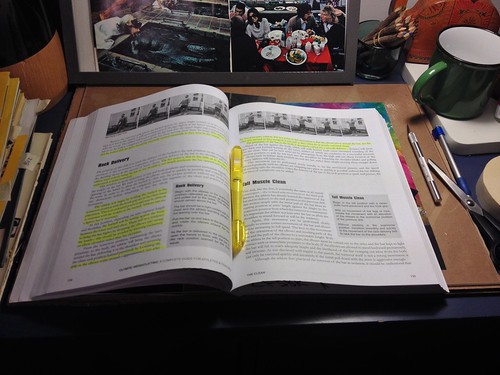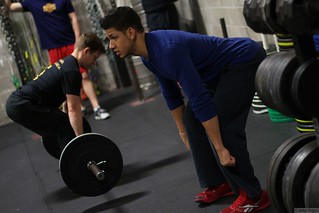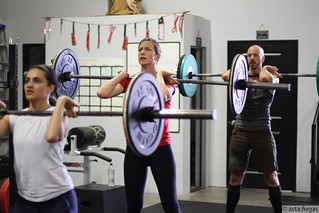Continuing Education: A Sample Test About Cleans
 Sunday, January 5, 2014 at 4:54PM
Sunday, January 5, 2014 at 4:54PM

In our November article “Continuing Education: Giving Coaches Tests,” we wrote about our ongoing in-house education, and how almost two years ago, I started creating and administering graded tests as an attempt to increase the quality and consistency of our coaching staff. As our gym grew, it became clear that we all needed to be on the same page regarding our basic understanding of the information that we’re accountable for on a daily basis. Christian Fox, one of the coaches who’s been with our gym the longest, just wrote a new test for CFSBK, called “Clean Foundations and Progressions Part 1,” (Part 2 to come!) which can be found below, along with the study guide. Let’s meet Fox and hear some of his thoughts about his test…
Olympic Weightlifting Test: Clean Part 1 (Blank Test)
Olympic Weightlifting Test: Clean Part 1 (Our Answer Key)
Coaches Study Guide
What does the test teach?
The first part is about the start and finish positions of the clean from the basic mid hang position, and then the drills that we use in the teaching portion of our group classes. (When we organize a class, we use these drills to warm up athletes before their open lifting time.) The test is pulled from Greg Everett's book Olympic Weightlifting: A Complete Guide for Athletes and Coaches (Second Edition).
 Chris Fox CleaningTell us about the test you created. Why this particular subject?
Chris Fox CleaningTell us about the test you created. Why this particular subject?
We do a lot of Olympic weightlifting at CFSBK, and there are varying styles to teach the lifts. In group classes, we need to use one style, so the coaches can all be on the same page with the progressions. Creating a test about cleans is an opportunity for the nine of us—even if we’ve been teaching the lift for years—to learn something new and refresh our knowledge. For some of our newer coaches that aren’t as experienced with teaching Olympic weightlifting, it helps them learn why certain progressions exist, and more about some of the subtleties of the positionings we use. For the more experienced coaches, you can always learn something from someone else’s point of view, or even from rereading something you’ve read in the past.
How does this test fit within the greater context of tests in this series?
This first test is about the mid hang clean—so we’re not pulling from the floor. The next test, Part 2, reviews the full lift from the floor, what we’re looking for there, and the drills to teach that part of the lift. The rest of Part 2 is more troubleshooting. Say someone is losing the bar forward, what do you do? If the bar keeps dropping on someone’s clavicle, what are some methods you can do to correct their movement? Part 3 of the series will be looking at some videos of cleans performed by various athletes in group classes. We’ll sit down during our weekly coaches meeting, go over what was good and what was bad about the athletes’ movements, and depending on what’s bad, what we would do to fix it.
How was this test graded?
This test had 13 questions, and of those, the multiple choice and true/false were worth one point, and the short answers were worth two points, and the couple short essay questions were worth four points. We give grades on the test, but the grades aren’t there to say that one coach is better than another coach. Our goal is for everyone to score 90% correct or greater. If they score less than that, it’s just an indicator that we need to sit down and work through what they got incorrect. Maybe they didn’t understand the way the questions were phrased or some of the material, so we’ll troubleshoot. The goal isn’t really grading; it’s having a barometer to gauge how we can get our knowledge up to the same level.
 Using similar language helps members hear a consistent messageWhat do you think the coaches got out of this test?
Using similar language helps members hear a consistent messageWhat do you think the coaches got out of this test?
I think we acquired some consistent language for positions we use on drills for the clean. With this lift, we’d been playing with Glenn Pendlay’s California Strength teaching progressions, which use the terms Position 1, Position 2, and Position 3. These positions are a little different than Greg Everett’s book Olympic Weightlifting: A Complete Guide for Athletes and Coaches (Second Edition)—which is what we’ve switched to now. But if one coach is teaching Pendlay’s progression, and another coach teaches Everett’s progression, and still another coach is teaching Mark Rippetoe’s version, then different classes are potentially learning very different approaches to the movement.
This isn’t quite related to the question, but it’s worth noting that our programming structure focuses not just on creating continued exposure to certain lifts, but on teaching very specific portions and segments of the lifts. With something as nuanced as the clean, there’s not one way to teach it, but collectively as a gym, we should all be on the same page and using the same language and teaching it in the same way. If an athlete is having a tough time with something, then it’s the coach’s job to get in there and make adjustments with whatever other language seems most appropriate or helpful.
What are some benefits of giving coaches tests, from the perspective of someone who has both taken and administered them? Warming up power cleans
Warming up power cleans
I think it’s fun to learn. Most people in this business are constantly learning something. Exercise science is kind of a nefarious term, since there’s not really a lot of “science” behind some of these things. But tests help you to get better as a coach and personal trainer, and as an individual athlete as well. I hadn’t previously focused on some of the nuanced elements of the clean, and creating this test has translated to my own training. It’s also a focal point that enables team building with our coaching staff. We get to have a conversation. People will get together and study for certain things, and share what they do or don’t understand. Furthermore, while most of our staff are full-time, a couple of them are part-time and don’t come to the weekly coaches meeting, but they’re part of the conversations about the tests. So these tests keep everyone together. Also, we’re constantly striving to up the knowledge base of our staff.
Most importantly, if you could be any superhero, which one would you be?
I always say the Hulk, so I’ll probably stick with that.
_____________________
Do you have any ideas for tests you might like to write for your coaches?

Reader Comments (1)
Great post! Thanks for the resource!